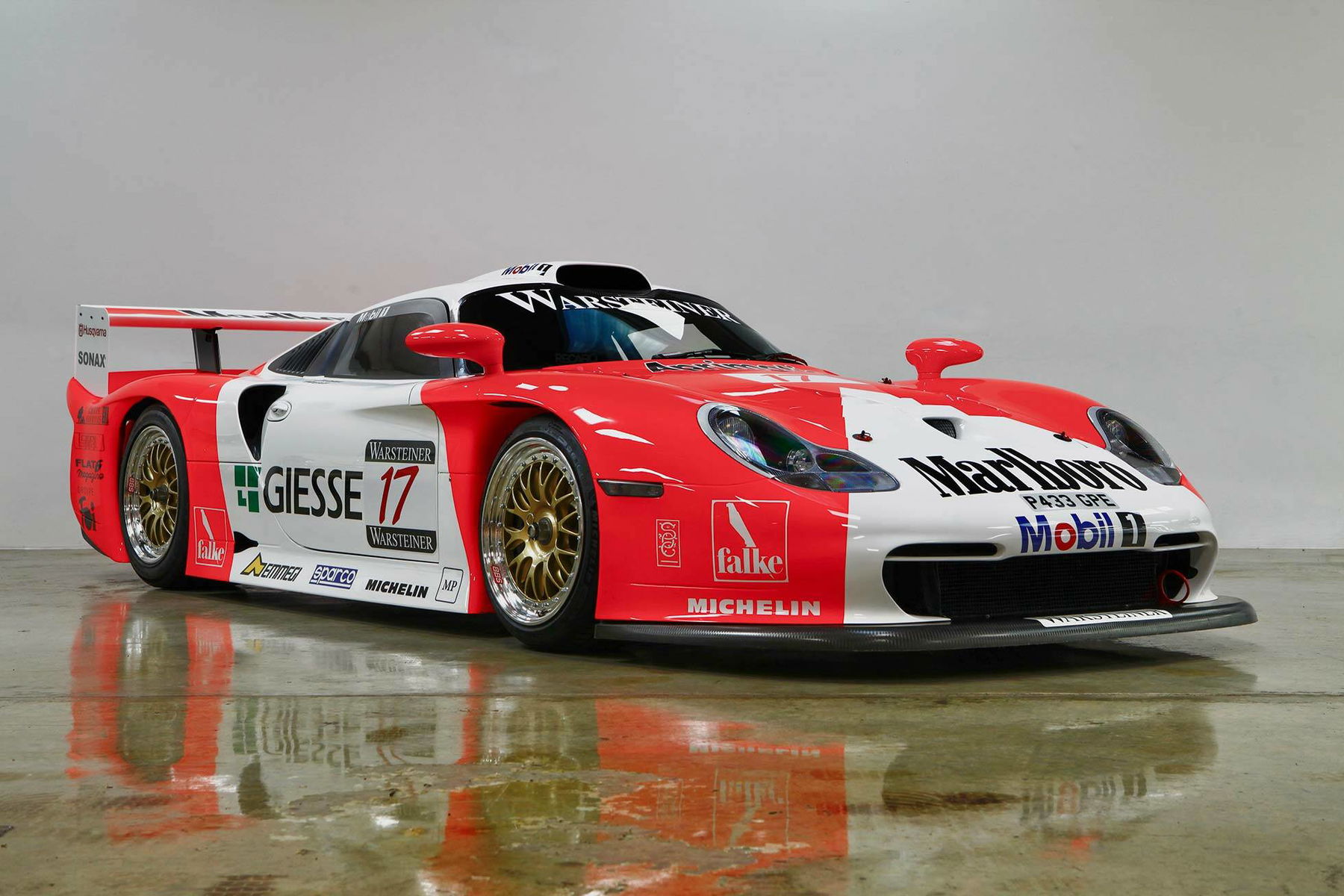Following McLaren’s outright win at the 1995 24 Hours of Le Mans with the production-based F1 GTR, Porsche began to seriously rethink the future of their GT1 program. With the 911 GT2 Evos unable to compete in the GT1 class, Norbert Singer and Horst Reitter evaluated the requirements to find a workable solution. Their conclusion was both radical and effective: build a mid-engine 911 based on the contemporary 993 and construct a limited run of street-legal production cars for homologation purposes. While recognizable as a 911, the GT1 was essentially a pure prototype, complete with a special tube-frame chassis, composite panels, sophisticated double-wishbone suspension, Brembo brakes and a water-cooled, twin turbocharged flat six.
The debut at the 1996 24 Hours of Le Mans did not disappoint. The two works entries finished 2nd and 3rd overall, with GT1-002 taking victory in the GT1 class. From there, the GT1s went on to success in the BPR series, proving that the McLaren F1s were not unbeatable.
Over the winter of 1996–1997, the Porsche racing department further developed the works GT1 for the 1997 Le Mans effort. Dubbed the GT1 Evo, the new model was a considerable improvement over the original and was immediately distinguished by its redesigned bodywork, complete with the “teardrop” headlamps which previewed the all-new generation of the (996) production 911 – unveiled in 1997.
Beneath the bodywork, the front end of the car was revised including new aero and an optimised front suspension with widened track. These measures all resulted in improved significantly improved handling and lap-times.
This car
Manufactured by Porsche Motorsport and delivered new on 24th April 1997 to Messrs. FINLIGA S.A. and run by Konrad Motorsports (Germany). The car first appeared with Konrad Motorsports in GT1-96 spec (993 headlamps) running during the first half of the 1997 World FIA GT Championship, wearing Green-Blue Giesse / Warsteiner livery:
1997 World FIA GT Championship
• Le Mans Pre-qualifications
• Silverstone
• Helsinki
• Nürburgring
• Le Mans 24 hours
• Spa
In August 1997, GT1-109 was one of two customer GT1 cars sent back to Weissach for Porsche Motorsport to convert to 1997 Evo specification –
Upon completion the car was sold to JB Racing (France) for the remainder of the 1997 season. JB Racing already had a lucrative Marlboro sponsorship deal for their GT1-96 chassis 101 and upgraded cars mid-season to the newly converted GT1-109 Evo, running it in Marlboro livery for the remainder 97 FIA GT season:
• Mugello
• Laguna Seca
• Sebring 12 hr
For the 1998 season the car was then acquired by Labre Competition (France) and re-liveried with new sponsorship from Sony Playstation. GT1-109 would go onto appear in just three times before being retired from racing:
1997 World FIA GT Championship
• Dijon
• Hungaroring
• Le Mans pre-qualification
Ownership Provenance:
1997
Messrs. FINLIGA S.A.
(Germany)
1997
JB Racing
(France)
1998
Labre Competition
(France)
2005
Mr Gerry Harrison
(UK)
2005
Mark Sumpter
(UK)
2021
Present owner
(UK)
Fully rebuilt and maintained by X-Tech Engineering between 2007 – 2020. The (M96/80) 6-cylinder 3200cc engine was rebuilt with a new crankshaft from Porsche, along with Mahle pistons, liners and titanium con rods, chains, valves, valve springs, etc – all dyno tested to 650bhp at 7,600 rpm.
GT1-109 also received a new wiring loom during the rebuild. The original TAG engine management system was kept to one side and replaced with a Motec unit. Updating the electronics to make the car more user friendly and able to access data logging more easily to keep on top of any potential problems before they occur.
In 2022, Maxted-Page were commissioned to restore the car to Marlboro livery and to prepare the car for road registration.
A full body carbon repaint was professionally carried out by Normandale. Then, in addition to replacing all normal lifed items such as fuel bladder, harnesses and extinguisher system, several (reversable) modifications were planned and made to make the car more compliant for road use. These included :
• Changing carbon race discs for steel brake discs
• Fitment of Auxiliary front cooling fans
• Handbrake
• Softer spring and damper settings
• Secondary fire extinguisher system
• Live rear-view camera
• Stilo Intercom for driver – passenger and telephone
• Michelin Pilot Sport 275/35 ZR 18 Front and 345/35 ZR 18 Rear tyres
The car remains unraced since period, with low hours and is presented in immaculate condition with fully documented history file and provenance.
One of only nine customer GT1 race cars ever built and one of two to be converted by the factory to full 97 Evo configuration.
Eligible for entry to all the most prestigious car events in the world, as well as for racing in Endurance Racing Legends or simply driving on the road!
Technical Specification
Engine
Type M96/80 – 3,164cc six-cylinder, aluminium-engine block and cylinder heads, dry sump lubrication, water-cooled block and heads, 4-valves per cylinder, twin KKK Turbo and TAGtronic 3.8 electronic engine management.
Gearbox
(G96/80)
6-speed manual
Gear ratios
1st gear 13/41; 2nd gear 20/40; 3rd gear 21/33; 4th gear 29/36; 5th gear 33/35; 6th gear 34/31
Power
600 Bhp / 440 KW at 7,200 rpm (with 35.7 mm twin air restrictors)
650 Nm at 5,500 rpm
Chassis
Front section basis 993 sheet-steel to B-pillar with enclosed rear bulkhead. Load bearing tubular steel rear structure in which the engine and transmission were mid-mounted.
Bodywork
Kevlar / Carbon Fibre composite
Steering
Power steering
Brakes
Carbon disc brakes front and rear, hydraulic servo unit (steel)
Discs
Front: 380x37mm
Rear: 380x37mm
Wheels
Front: 11.5×18” ET49
Rear: 13×18” ET66
ABS
Bosch ABS
Dimensions
Weight: ca. 1000kg
Length: 4683mm
Width: 1946mm
Height: 1173mm
Anciliaries
Air jacks
100-litre fuel tank with integrated catch tank










































